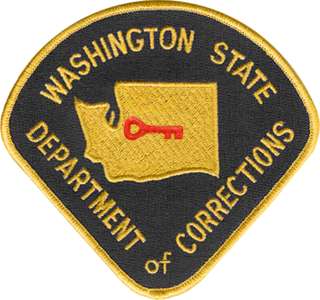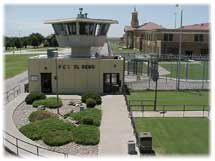
The Washington State Department of Corrections (WADOC) is a department of the government of the state of Washington. WADOC is responsible for administering adult corrections programs operated by the State of Washington. This includes state correctional institutions and programs for people supervised in the community. Its headquarters are in Tumwater, Washington.

Minnesota Correctional Facility – Oak Park Heights (MCF-OPH) is Minnesota's only Level Five maximum security prison. The facility is located near the cities of Bayport and Stillwater. The facility is designed and employed with trained security officers to handle not only Minnesota's high-risk inmates but other states' as well. They also have the largest contract to house federal inmates with serious, violent histories. The prison has never had an escape, and only one homicide.

The Long Bay Correctional Complex, commonly called Long Bay, is a correctional facility comprising a heritage-listed maximum and minimum security prison for males and females and a hospital to treat prisoners, psychiatric cases and remandees, located in Malabar, Sydney, New South Wales, Australia. The complex is located approximately 14 kilometres (8.7 mi) south of the Sydney CBD and is contained within a 32-hectare (79-acre) site. The facility is operated by Corrective Services New South Wales, a department administered by the Government of New South Wales.

The Silverwater Correctional Complex, an Australian maximum and minimum security prison complex for males and females, is located in Silverwater, 21 km (13 mi) west of the Sydney central business district in New South Wales, Australia. The complex is operated by Corrective Services NSW, an agency of the New South Wales Government Department of Communities and Justice.

The New Jersey State Prison (NJSP), formerly known as Trenton State Prison, is a state men's prison in Trenton, New Jersey operated by the New Jersey Department of Corrections. It is the oldest prison in New Jersey and one of the oldest correctional facilities in the United States. It is the state's only completely maximum security institution, housing the most difficult and/or dangerous male offenders in the inmate population. NJSP operates two security units and provides a high level of custodial supervision and control. Professional treatment services, such as education and social work, are a priority at the facility. The Bureau of State Use Industries operated the bedding and clothing shops that were once located in Shop Hall at the facility. These industries have been relocated to South Woods State Prison.
Pontiac Correctional Center, established in June 1871, is an Illinois Department of Corrections maximum security prison for adult males in Pontiac, Illinois. The prison also has a medium security unit that houses medium to minimum security inmates and is classified as Level 3. Until the 2011 abolition of the death penalty in Illinois, the prison housed male death row inmates, but had no execution chamber. Inmates were executed at the Tamms Correctional Center. Although the capacity of the prison is 2172, it has an average daily population of approximately 2000 inmates.
The Twin Rivers Corrections Center opened in 1984 and is part of the Monroe Correctional Complex facility in Monroe, Washington. Currently, it is the largest prison in all of Washington State. It is now referred to as Twin Rivers Unit (TRU). It currently employs 1200 people. Monroe Correctional Complex is a Close, Medium, and Minimum security facility, which houses approximately 2800 inmates in five wings, typically two to a cell. Some inmates with special needs are housed in individual cells. Inmates are generally required to participate in some kind of program, whether it is educational, treatment, or Class III industries. Such programs may include earning a General Educational Development (GED) certificate, or sexual offender or chemical dependency treatment. Class III industries include janitorial, clerical or kitchen work, for example.

The Massachusetts Correctional Institution at Concord (MCI-Concord) is a medium security prison for men located in Concord, Massachusetts in the United States. Opened in 1878, it is the oldest running state prison for men in Massachusetts. This prison is under the jurisdiction of the Massachusetts Department of Correction. There are 570 inmates with a total capacity of 614 general population beds.
The Pendleton Correctional Facility, formerly known as the Indiana Reformatory, is a state prison located in Fall Creek Township, Madison County, near Pendleton and about 25 miles (40 km) northeast of Indianapolis. Established in 1923, it was built to replace the Indiana State Reformatory located in Jeffersonville after a fire severely damaged the original property. The Pendleton facility currently offers maximum and minimum-security housing for adult males over 22 years old. The maximum-security portion is made up of 31 acres (130,000 m2) surrounded by a concrete wall. It has an average daily population of approximately 1,650 inmates. Located on the grounds outside the enclosure, the minimum-security dormitory holds approximately 200 prisoners on a daily basis.

The Ohio Reformatory for Women (ORW) is a state prison for women owned and operated by the Ohio Department of Rehabilitation and Correction in Marysville, Ohio. It opened in September 1916, when 34 female inmates were transferred from the Ohio Penitentiary in Columbus. ORW is a multi-security, state facility. As of July 2019, 2,394 female inmates were living at the prison ranging from minimum-security inmates all the way up to one inmate on death row. It was the fifth prison in the United States, in modern times, to open a nursery for imprisoned mothers and their babies located within the institution. The Achieving Baby Care Success (ABC) program was the first in the state to keep infants with their mothers.

The Kentucky State Penitentiary (KSP), also known as the "Castle on the Cumberland," is a maximum security and supermax prison with capacity for 856 prisoners located in Eddyville, Kentucky on Lake Barkley on the Cumberland River, about 4.8 kilometres (3 mi) from downtown Eddyville. It is managed by the Kentucky Department of Corrections. Completed in 1886, it is Kentucky's oldest prison facility and the only commonwealth-owned facility with supermax units. The penitentiary houses Kentucky's male death row inmates and the commonwealth's execution facility. As of 2015 it had approximately 350 staff members and an annual operating budget of $20 million. In most cases, inmates are not sent directly to the penitentiary after sentencing, but are sent there because of violent or disruptive behavior committed in other less secure correctional facilities in the commonwealth. This was Kentucky's second penitentiary: the first was made uninhabitable from a flood in 1937.
The Correctional Industrial Facility, otherwise known as the CIF, is an Indiana Department of Corrections prison located in Fall Creek Township, Madison County, near Pendleton. It is a medium-security prison. As of 2019, the prison housed 1,471 inmates, and employed 307 staff. Constructed in 1985, CIF formerly housed the Indiana Department of Correction's PEN food products plant. However, the food products plant was replaced by a brake refurbishing factory in partnership with the industrial company Meritor, which is the largest employer of offenders in the facility. Wendy Knight is the current Warden of CIF.

The Union Correctional Institution, formerly referred to as Florida State Prison, Raiford Prison and State Prison Farm is a Florida Department of Corrections state prison located in unincorporated Union County, Florida, near Raiford.

Federal Correctional Institution, El Reno is a medium-security United States federal prison for male inmates in Oklahoma. It is operated by the Federal Bureau of Prisons (BOP), a division of the United States Department of Justice. The facility has an adjacent satellite camp for minimum-security male offenders.

State Correctional Institution (SCI) Cambridge Springs is a minimum-security correctional facility for females in Cambridge Springs, in Crawford County in northwestern Pennsylvania. The majority of the inmates housed here are nearing their release from prison.
Joseph Harp Correctional Center (JHCC) is an Oklahoma Department of Corrections state prison for male inmates located in Lexington, Cleveland County, Oklahoma. The medium-security facility opened in September 1978 and with a capacity of 1045 inmates is the largest medium-security prison in the state.
Washington Corrections Center for Women is a Washington State Department of Corrections women's prison located in Gig Harbor, Washington. With an operating capacity of 740, it is the largest women's prison in the state and is surrounded by Washington State Route 16, and McCormick forest park. It opened 53 years ago in 1971, 82 years after statehood.
Lexington Assessment and Reception Center (LARC) is a maximum-security state prison for men located in Lexington, Cleveland County, Oklahoma, owned and operated by the Oklahoma Department of Corrections. The LARC complex also hosts the medium-security Lexington Correctional Center and the Rex Thompson Minimum Security Unit.
The Buena Vista Correctional Facility is a state prison for men located in Buena Vista, Chaffee County, Colorado, owned and operated by the Colorado Department of Corrections. The facility opened as an adult prison in 1978, and houses 871 inmates at medium and close security levels, along with the 288-inmate Buena Vista Minimum Center, and another 100 minimum security inmates within the Colorado Correctional Alternative Program. The Boot Camp is closed today. The close security facility is known to inmates as "The Buildings" and the Minimum is known as "The Mods". The prison is split into 6 Housing units A&O which is an Orientation unit that inmates are placed in when they first arrive to the prison. Segregation is the unit where inmates are placed for disciplinary actions, North Unit, Lower North Unit, East Unit and South Unit which houses the majority of the prisons active gang members and violent offenders. In the late 90s and Early 2000s "The Buildings was referred to as "Gladiator School" because most of Colorado's younger gang members were sent there. During that time the fighting and violence was at a record High in the State.
The Maine Correctional Center is a medium/minimum security prison in South Windham, Maine. It is operated by the Maine Department of Corrections and has an inmate capacity of 662, making it the second largest prison in the state. All residents sentenced to less than five years are directly admitted to this facility.












